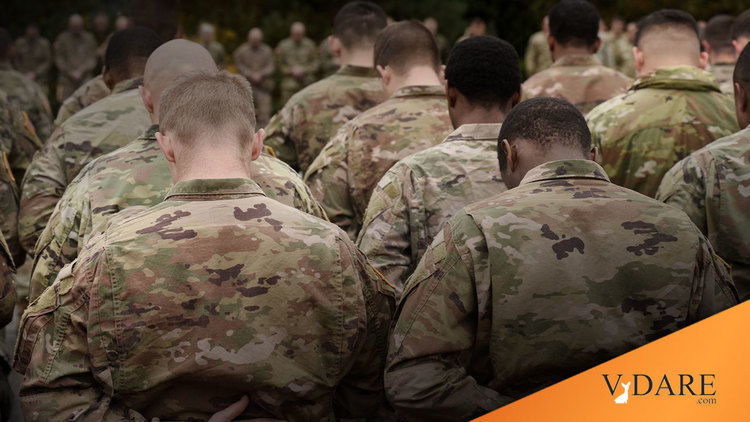The racial situation in the military was thrust back into the news recently when Rep. Charles Rangel (D-Harlem) proposed reinstating the draft. The Korean War veteran offered a good argument and a bad one. ["Bring Back the Draft," New York Times Op-Ed, Dec 31, 2002, by Charles B. Rangel.]
Rangel's good argument: when members of today's political elite contemplate sending America's all-volunteer forces into harm's way, they are in little danger of personally losing family members. Among the children of the 535 members of Congress are found only a handful of officers and a single enlisted man.
It wasn't always like this. Sons of President Theodore Roosevelt died in both WWI and WWII. Teddy Roosevelt Jr. won the Medal of Honor landing in the first wave at Normandy at the age of 56.
Rangel's bad argument: "A disproportionate number of the poor and members of minority groups make up the enlisted ranks of the military…"
This just isn't true. While blacks are heavily represented in the military in general, they make up only 15 percent of the combat ranks - just barely above their share of younger Americans.
Moreover, they are fairly rare in exclusive jobs such as pilots and Special Forces. As I noted in my movie review of Black Hawk Down, the remarkably authentic film of the ill-fated 1993 raid in Somalia, of the 40 American soldiers depicted (all of them Rangers or ultra-elite Delta Force commandos), only one was black.
If all goes according to plan, these carefully selected warriors would do most of the fighting. Of course, wars don't always go according to plan…
Combat units have gotten whiter because a lot of young white guys join up to "play Rambo" for four years and then go to college using military tuition benefits. In contrast, more blacks view the military as a long-term career.
If you intend to stay in until you are 40 or 50, it makes a lot of sense to pursue a specialty that offers plenty of desk jobs. Crawling on your belly and sleeping in the mud might sound like fun if you aren't staying past your early 20s, but it gets old awfully fast as you yourself get older.
The military, especially the Army, is famous for how well blacks and whites get along. The high level of black accomplishment, with its accompanying equality and amity, is often held up as a model for the rest of society.
Much of what the Army does is well worth studying, as I pointed out in my 1995 article "Where the Races Relate," which explained to university administrations what they could copy from the Army to improve race relations on campus. (Amazingly, they didn't listen.) The fine 1997 book All That We Can Be: Black Leadership and Racial Integration the Army Way by sociologists Charles C. Moskos and John Sibley Butler gives a detailed view.
It would be wonderful if racial gaps could be made to disappear with just a little discipline. But the Army has a secret weapon: it carefully selects which applicants it accepts. Black and white recruits are quite equal even before they join up.
Even in the 1970s when the quality of white recruits was low, respectable black families were proud to send their children into the Army. Back then, according to Moskos and Sibley, 90 percent of black enlistees were high school graduates, compared to only 40 percent of whites.
After President Reagan raised soldiers' pay and helped make patriotism fashionable again, the capabilities of white enlistees rose sharply. Now, virtually all recruits have high school diplomas.
White and black enlistees come from families with similar incomes. A 1999 Defense Department study found that among American households as a whole, the average income for whites was $44,400 and for blacks $27,900. Among enlistees, however, the racial gap was almost non-existent. White recruits came from households averaging $33,500 per year versus $32,000 for blacks - i.e. a figure well above the black national average.
Perhaps most importantly, the Army is a heavy user of aptitude tests. A surprisingly high fraction of young Americans are ineligible to join the Army because of lack of intelligence – extrapolating from Moskos and Sibley's figures, about a fifth of all whites and three-fifths of all blacks wouldn't make the cut.
The brain power of those accepted is impressive. Moskos and Sibley found that in 1994
"83 percent of white recruits scored in the upper half of the mental aptitude test (compared with 61 percent of white youths in the national population), while 59 percent of black recruits scored in the upper half (compared with 14 percent of the black youths nationwide)."
In other words, the Army's black enlisted personnel score just as well on the general aptitude test as the average white American. (African-American officers average even better, of course.)
There are still differences, so whites tend to predominate in the most intellectually-challenging military jobs. Still, by drawing just from blacks with relatively high IQs, the Army has managed to sidestep a huge number of problems.
So the magic race relations bullet that the military has found turns out to be - IQ tests.
And keeping out the lower-scorers.
This will be hard to apply in America at large.
[Steve Sailer [email him] is founder of the Human Biodiversity Institute and movie critic for The American Conservative. His website www.iSteve.blogspot.com features his daily blog.]
January 26, 2003













